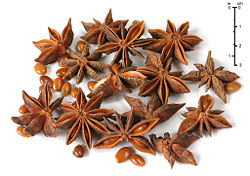Star anise
| Star anise | ||||||||||||||
|---|---|---|---|---|---|---|---|---|---|---|---|---|---|---|
 Star anise fruits (Illicium verum)
|
||||||||||||||
| Scientific classification | ||||||||||||||
|
||||||||||||||
| Binomial name | ||||||||||||||
| Illicium verum Hook.f. |
Star anise, star aniseed, badiane or Chinese star anise, (Chinese: 八角, pinyin: bājiǎo, lit. "eight-horn") (Malayalam: തക്കോലം ) is a spice that closely resembles anise in flavor, obtained from the star-shaped pericarp of Illicium verum, a small native evergreen tree of southwest China. The star shaped fruits are harvested just before ripening. It is widely used in Chinese cuisine, in Indian cuisine where it is a major component of garam masala, and in Malay/Indonesian cuisine. It is widely grown for commercial use in China, India, and most other countries in Asia. Star anise is an ingredient of the traditional five-spice powder of Chinese cooking. It is also one of the ingredients used to make the broth for the Vietnamese noodle soup called phở. It is used as a spice in preparation of Biryani in Andhra Pradesh, a south Indian State.
Contents |
Usages
Culinary uses
Star anise contains anethole, the same ingredient which gives the unrelated anise its flavor. Recently, star anise has come into use in the West as a less expensive substitute for anise in baking as well as in liquor production, most distinctively in the production of the liquor Galliano. It is also used in the production of Sambuca, pastis, and many types of absinthe.
Medicinal uses
Star anise has been used in a tea as a remedy for colic and rheumatism, and the seeds are sometimes chewed after meals to aid digestion.
Shikimic acid, a primary feedstock used to create the anti-flu drug Tamiflu, is produced by most autotrophic organisms, but star anise is the industrial source. In 2005, there was a temporary shortage of star anise due to its use in making Tamiflu. Late in that year, a way was found of making shikimic acid artificially. A drug company named Roche now derives some of the raw material it needs from fermenting E. coli bacteria. There is no longer any shortage of star anise and it is readily available and is relatively cheap.
Star anise is grown in four provinces in China and harvested between March and May. The shikimic acid is extracted from the seeds in a ten-stage manufacturing process which takes a year. Reports say 90% of the harvest is already used by the Swiss pharmaceutical manufacturer Roche in making Tamiflu, but other reports say there is an abundance of the spice in the main regions - Fujian, Guangdong, Guangxi and Yunnan.
Japanese star anise (Illicium anisatum), a similar tree, is not edible because it is highly toxic (due to containing sikimitoxin); instead, it has been burned as incense in Japan. Cases of illness, including "serious neurological effects, such as seizures", reported after using star anise tea may be a result of using this species. Japanese star anise contains anisatin, which causes severe inflammation of the kidneys, urinary tract and digestive organs.
Production
Syrian Arab Republic is leader in production of anise, badian, fennel & corian followed by India.
| Top Ten Anise, Badian, Fennel & Corian Producers — 11 June 2008 | ||||
|---|---|---|---|---|
| Country | Production (Tonnes) | Footnote | ||
| 115000 | F | |||
| 110000 | F | |||
| 52000 | F | |||
| 38000 | F | |||
| 30000 | F | |||
| 28100 | F | |||
| 23000 | F | |||
| 22000 | F | |||
| 19641 | ||||
| 9800 | F | |||
| 496438 | A | |||
| No symbol = official figure, P = official figure, F = FAO estimate, * = Unofficial/Semi-official/mirror data, C = Calculated figure A = Aggregate(may include official, semi-official or estimates); |
||||
Identification
- Refer to the 4th edition of the European Pharmacopoeia [1153].
Differentiation with other species
Joshi et al. have tried the techniques of fluorescent microscopy and gas chromatography[1] to distinguished the species, while Lederer et al. employed the state of the art which combines the technology of TLC with HPLC-MS/MS.[2]
References
Notes
- ↑ Joshi, Vaishali C. et al. (2005). "Rapid and Easy Identification of Illicium verum Hook. f. and Its Adulterant Illicium anisatum Linn. by Fluorescent Microscopy and Gas Chromatography". Journal of AOAC International (AOAC International) 88 (3): 703–706. doi:. PMID 15492355. http://www.atypon-link.com/AOAC/doi/abs/10.5555/jaoi.2005.88.3.703. Retrieved on 10 November.
- ↑ Lederer, Ines et al. (2006). "Combination of TLC and HPLC-MS/MS Methods. Approach to a Rational Quality Control of Chinese Star Anise". Journal of Agricultural and Food Chemistry (American Chemical Society) 54 (6): 1970–1974. doi:.
Bibliography
See also
- Japanese star anise
External links
|
||||||||||||||||||||||||||||||||||||||||||